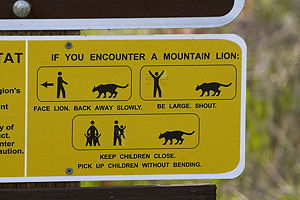Panther, Person, Porcupine
| Panther, Person, Porcupine | |
|---|---|

| |
| Designer: | Bernie DeKoven, funsmith |
| Year: | unknown |
| Players: | 12+ |
| Stuff required: | None. |
| Crew required: | None. |
| Preparation: | None. |
| Time required: | Half an hour upwards. |
| Place required: | Anywhere with space to run. |
| Activities: | Chasing, bluffing. |
| This is a playable game - it's finished, tested and ready to play. | |
| This game is made available under an Attribution-Noncommercial Creative Commons licence. (What does this mean?) | |
This is a game I wind-up playing alot in my workshops. I guess because it's easy, fun, silly, only remotely competitive, and rich with discussion-worthiness.
Rules
There are three positions. Each position has an accompanying sound. I like to ask people to make up both the position and the sound. The Panther position, for example, might be hands like claws, extended, with accompanying roar. The Porcupine position, of course, will require an leap of silliness. If you don't like porcupines, you can try perhaps persimmons or purple painted palomino ponies.
Like Rock/Scissors/Paper, each one beats the other - the Panther bets the Person, the Person the Porcupine and the Porcupine the Panther.
People get into three teams. Each team, as a whole, decides what position it wants to take. When ready, all three times line up in a triangle and display their choice. The team that wins takes a person from each team that it beats. There are two ways that the game can be tied - when all choose the same or when all choose something different. The vast implications of this are quite potentially significant.
We recommend that you play until there are only two teams left. If you want the game to go on for another hour or so, continue until everyone is on one team.
The game leaves a lot for processing: leadership, decision-making, strategy and counter-strategy, what was fun, etc. Have fun with it, and the learning will follow.
I first learned of this game as "Tiger, Man, Gun" - a South American children's game played by two teams. (For more two-team variations, see this.) Over the years, the game became "Panther, Person, Pistol" (more fun to say). I developed the three-team variation for larger groups, and as a springboard for extending the game into a simulation. After we'd play a few rounds, I'd introduce an opportunity for teams to send representatives to other teams and make deals (we'll be Panthers if you'll be Panthers, too). This became a powerful little simulation of the politics of bargaining and negotiation strategies, and, because everyone knew that everyone else was probably lying, a lot of fun. Later, the Pistol became a Python, a Porcupine and even a Persimmon. The "hugging person" and playing until everyone was the on the same side were both introduced during the August, 2002 session at Esalen.
Finally, for a bit of ultimate solidarity, try playing with a lot of teams - five, six or more even. When a team loses, the entire team joins team joins the winning team. Continue until there's only one team left.